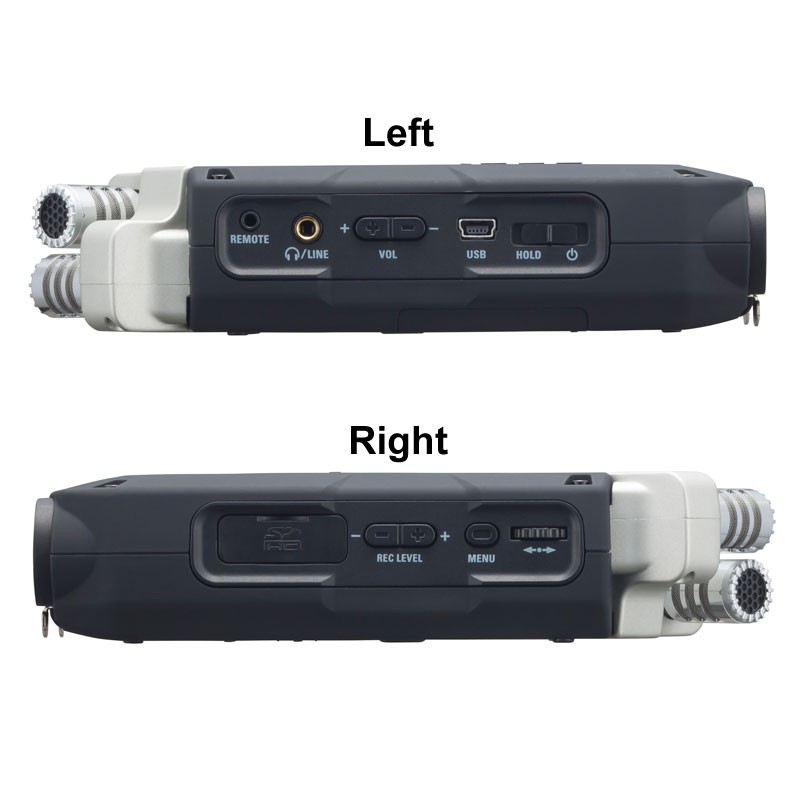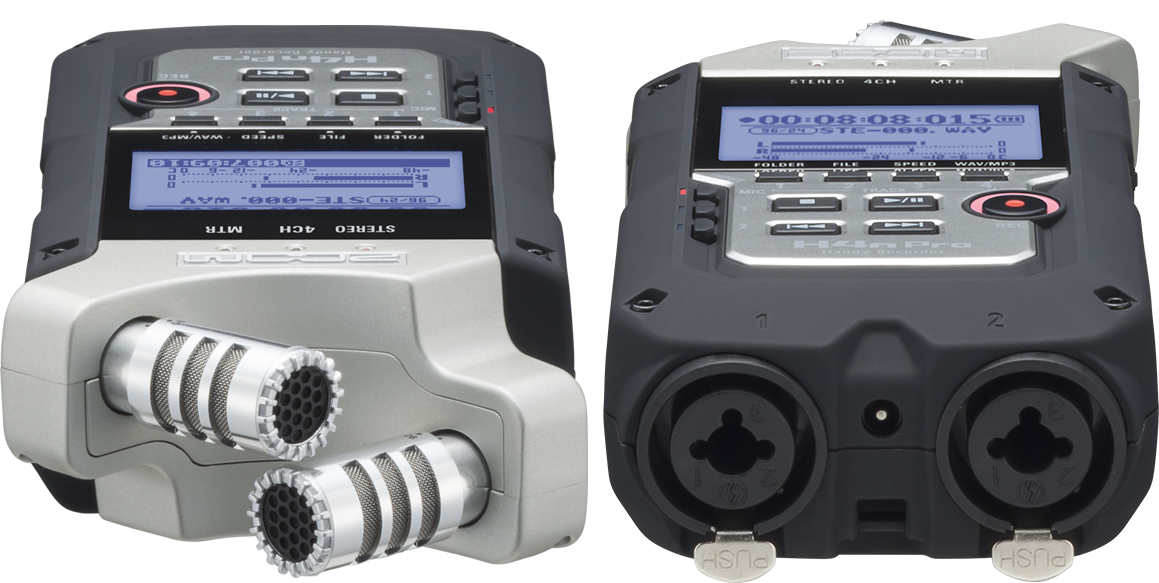
Last week I looked at the ZOOM H5 Audio Recorder, and in this blog I am going to look at its cousin the ZOOM H4n Pro Audio Recorder. Both of these units are similar in their price points and features yet have a couple of key differences that serve to set them apart from one another. These small, yet important, differences will likely dictate which model you would select to meet your particular needs. The H4n Pro is a field recorder that can record quality audio and is an excellent way for filmmakers, both at the indie level or for run and gun documentary style, to increase the quality significantly from their camera’s built in audio recorder. The H4n Pro is also a 2 input/2 output audio interface that can be used as an intermediary to capture audio into your computer and digital audio workstation (DAW) software like the included Cubase LE8 or Wavelab LE9 audio editing software. This unit is right at home working for you to record podcasts, film audio, music, or live news audio gathering and more.

Zoom H4n SPECS
The ZOOM H4n pro has the same new, low-noise preamp as featured on the H5 and H6 models which gives you more headroom in your recordings and thus more options. For example, if you are recording film audio and there are moments when the audio is quite quiet, you can increase the volume for those sections in post production without introducing any unwanted noise or hiss. It has a quality X/Y condenser microphone built-in and also has two XLR/TRS inputs for attaching external microphones. These are locking inputs which means that you will never have the unfortunate accidental removal of a mic cable when in the middle of recording. This is a nice feature that the H5 does not, unfortunately, have. The unit has a headphone jack so you can monitor exactly what is recording as well as a line out that you could connect to your camera’s audio input. Using this feature would increase your recorded audio quality without you having to sync it up later as it would record synced.

Like the H5 it is made to record very loud audio, up to 140db, so is ideal for live recordings without losing it all to clipping or a muddy wall of distortion. You can connect dynamic microphones for recording or condenser microphones as the H4n Pro does have phantom power. The XLR inputs are dual mode so you can also connect ¼” TRS cables from microphones or instruments. There is also a 1/8” input you could use, for instance, to connect a lavalier mic and then when finished, you can listen to what you have recorded through the H4n Pro’s built-in reference speaker. It has a USB output to connect to your computer for use as an audio interface or to transfer audio files. It has a rubberized case that encompasses the unit and, while I certainly wouldn’t want you to hurl it against the wall, it will be well protected for those little falls and mishaps that invariably occur. There is also an optional remote available.
RECORDING with the H4n
There are 3 primary ways to use the H4n Pro to record audio which is a hallmark to its versatility. You can record in Stereo Mode using the built in X/Y microphones or by attaching external microphones via the XLR/TRS inputs. This mode is optimal for live performances, acoustic sessions, or live dialogue. Using a boom microphone in this mode allows you to capture audio to later sync with video as I demonstrate in the video. If you record in 4CH Mode, then you can use the X/Y mics simultaneously with up to 2 external mics which can catch an even better audio footprint from a room or let you record ambient audio while also recording a line out from a mixing board. MTR Mode (Multi-track) means that your H4n Pro is now a 4-track studio recorder and gives you access to the unit’s built-in effects and emulators, lets you do overdubs or punch-ins, and also lets you edit and alter existing sound files
COMPARISON w/H5
Both the H4n Pro and the H5 record can 24 bit audio at 96 Khz, can record volumes up to 140db, and have a USB interface among other shared traits. One of the primary differences, however, is with the microphones and versatility. As mentioned, the H4n Pro has the fixed X/Y mics built-in while the H5 comes with a removable X/Y capsule. As such, the H5 does have other capsules that can simply click in in place of the X/Y. The options include shotgun microphones or the EXH-6 which increases the number of inputs available for mics, mixers, instruments or music players. With a fixed mic system, the H4n Pro does not have the quick swap compatibility. The H5 also provides you the option of a backup recording with a level that is 12 dB lower than the regular recording and would be valuable in the event of unexpected loud noises that would distort the original file. The H4n Pro does not offer this feature. Two things the H4n Pro does offer that the H5 does not are built-in guitar, bass, and vocal effects. The H5 has compression and limiting features but the H4n Pro has a full suite of studio quality effects from tremolo and delay to chorus and pitch shifting. The H4n Pro also has amp and cabinet emulators, tuners, and a metronome. And as mentioned before, the H4n Pro has locking XLR inputs.
So when the dust settles, the ZOOM H5 and the H4n Pro have a lot in common but it is the differences that will ultimately decide where your money ends up. The H4n Pro is both a field recorder and an audio interface and the multitude of built-in effects and emulators may well be the characteristic that defines this unit. In the field, in the studio, or almost everywhere else you could ever need to record, the ZOOM H4n Pro can get the job done. Swing by your local Best Buy and see if it’s the right tool for you.



